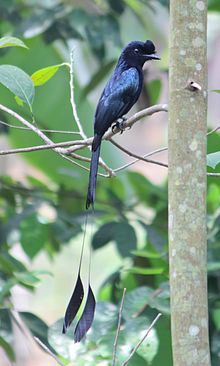Greater racket-tailed drongo
| Greater racket-tailed drongo | |
|---|---|
 |
|
| Scientific classification | |
| Kingdom: | Animalia |
| Phylum: | Chordata |
| Class: | Aves |
| Order: | Passeriformes |
| Family: | Dicruridae |
| Genus: | Dicrurus |
| Species: | D. paradiseus |
| Binomial name | |
|
Dicrurus paradiseus Linnaeus, 1766 |
|
| Synonyms | |
|
Dissemurus paradiseus |
|
Dissemurus paradiseus
Dissemuroides paradiseus
Edolius grandis
The greater racket-tailed drongo (Dicrurus paradiseus) is a medium-sized Asian bird which is distinctive in having elongated outer tail feathers with webbing restricted to the tips. They are placed along with other drongos in the family Dicruridae. They are conspicuous in the forest habitats often perching in the open and by attracting attention with a wide range of loud calls that include perfect imitations of many other birds. One hypothesis suggested is that these vocal imitations may help in the formation of mixed-species foraging flocks, a feature seen in forest bird communities where many insect feeders forage together. These drongos will sometimes steal insect prey caught or disturbed by other foragers in the flock and another ideas is that vocal mimicry helps them in diverting the attention of smaller birds to aid their piracy. They are diurnal but are active well before dawn and late at dusk. Owing to their widespread distribution and distinctive regional variation, they have become iconic examples of speciation by isolation and genetic drift.
In most of its range in Asia, this is the largest of the drongo species and is readily identifiable by the distinctive tail rackets and the crest of curled feather that begin in front of the face above the beak and along the crown to varying extents according to the subspecies. The tail with twirled rackets is distinctive and in flight it can appear as if two large bees were chasing a black bird. In the eastern Himalayas the species can be confused with the lesser racket-tailed drongo, however the latter has flat rackets with the crest nearly absent.
This widespread species includes populations that have distinct variations and several subspecies have been named. The nominate form is found in southern India, mainly in forested areas of the Western Ghats and the adjoining hill forests of peninsular India. The subspecies in Sri Lanka is ceylonicus and is similar to the nominate form but slightly smaller. The subspecies found along the Himalayas is grandis and is the largest and has long glossy neck hackles. The Andaman Islands form otiosus has shorter neck hackles and the crest is highly reduced while the Nicobars Island form nicobariensis has a longer frontal crest and with smaller neck hackles than otiosus. The Sri Lanka drongo D. lophorinus used to be treated as a subspecies due to the suggestion that it formed hybrids with ceylonicus is considered a separate species in newer taxonomic treatments on the basis of their overlapping ranges. Specimens of the nominate form have sometimes been confused with lophorinus. Considerable variation in shape of the bill, extent of the crest, hackles and tail rackets exists in the island populations of Southeast Asia. The Bornean brachyphorus (=insularis), banguey of Banggai lack crests (banguey has frontal feathers that arch forwards) while very reduced crests are found in microlophus (=endomychus; Natunas, Anambas and Tiomans) and platurus (Sumatra). A number of forms are known along the Southeast Asian islands and mainland including formosus (Java), hypoballus (Thailand), rangoonensis (northern Burma, central Indian populations were earlier included in this) and johni (Hainan).
...
Wikipedia

